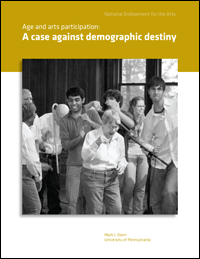Age and arts participation: A case against demographic destiny
2011, 104 pages, National Endowment for the Arts, 1100 Pennsylvania Avenue NW, Washington, DC, 20506, http://www.nea.gov
Download:
![]() Arts education in America: What the declines mean for arts participation (4.6Mb)
Arts education in America: What the declines mean for arts participation (4.6Mb)
A century ago, many Americans did not know exactly how old they were, so they often would round off their age to the nearest five years, a phenomenon that demographers call “age-heaping.” As late as 1910, for example, the U.S. Census listed 24 percent more 20-year-olds than 19-year-olds. The disappearance of age-heaping and its replacement by age consciousness — an increased sensitivity to the role of age and generation on behavior — by the middle of the 20th century represents a profound change in how Americans thought about their lives and their relationship to the rest of society. Today, age consciousness has so penetrated our society that one’s membership in a particular generation or birth cohort is often offered to explain a variety of behaviors — from consumption decisions to political preferences.
Age consciousness has affected our understanding of arts participation as well. Differences in rates of arts participation of the Baby Boomers and earlier and later generations have been of particular concern. Yet we might ask: has age consciousness gotten out of hand?
Specifically, does age matter to arts participation? The answer to that question depends on who is asking it. To an arts administrator who sees the average age of her audience increase year after year, it does matter, even if what she’s noting is simply the general aging of the population. From a sociological viewpoint, however, the question can be reframed: does knowing a person’s age or year of birth allow one to more accurately predict his or her level of arts engagement?
Age and cohort have a statistically significant — but weak — relationship to different measures of arts participation. Knowing someone’s age or year of birth provides very little power in explaining his or her level of arts participation. In this specific sense, age does not seem to matter. Other influences — educational attainment and gender, in particular — have a much stronger role in explaining arts participation.

